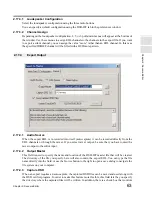
C
hap
te
r 2:
So
no
m
a
Edi
tor
Chapter 2: Sonoma Editor
51
2.13.10.2 Previous/Next Edit
These buttons select the next or previous edit by selecting the next or previous splice with a different
position from the current edit. If there is no current edit, the edit before or after the Nowline will be
selected.
2.13.10.3 Solo Checkbox
The solo checkbox puts the splice editor in solo mode, where you are editing only one channel of the
current splice. When you click the box to set the checkmark, the audition and edit enable controls for
the current channel are turned on and all other channels' audition and edit enable bits are turned off.
Once the solo box has been checked, every time you change the current channel (by clicking on
another splice in the current edit or using the
+/-
channel buttons) the current channel’s audition and
edit-enable controls will be turned off, and the new current channel’s controls will be turned on.
Unchecking the solo box cancels solo mode and resets the audition and edit buttons as if the splice
has just been selected. Pressing the
A
audition/edit column header or selecting a new edit also
cancels solo mode.
This button unsplices the current splice only. Like all splice commands, it affects only the edit
enabled channels. If all splice channels are enabled when this command is performed, there will be
no current splice afterwards and the control panel shows nothing. If some splice channels were
disabled, the ingredients in those channels remain in the current splice and the control panel and
graphics show the smaller splice (which now contains fewer channels).
Each time you perform an edit command, the Sonoma application saves the state of the EDL before
and after the command is performed (e.g., before cut, after cut) and stores these states in the Undo
list. When you undo a command it is transferred to the Redo list. The Undo and Redo lists appear as
pop-up menus in the Undo/Redo toolbar.
The pair of states for the most recently performed edit command appear first. When you select a state
on the Undo list, the EDL is restored to that state, and all the states above it are transferred to the
Redo list where they are listed in reverse order, oldest state first. You can redo a command (and all
those above it) by selecting from the Redo list.
The undo command restores the EDL to the most recent before-command state in the Undo list. The
redo command selects the most recent after-command state on the Redo list.
Note that while only states resulting from edit commands are saved on the Undo list, the collective
effect of any selection, cursor, and navigation commands is represented as the difference between
two consecutive after command/before command entries on the Undo list. To undo your non-edit
2.13.11
Unsplicing
2.14 Undo






























